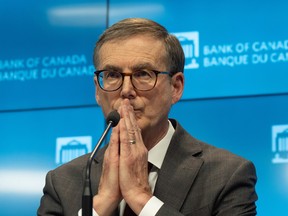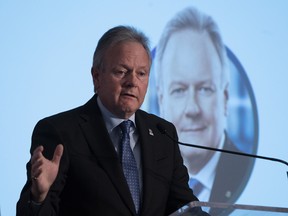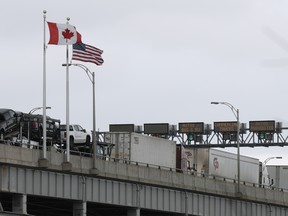Economists say it’s more of a wait and see game for the central bank now
Article content
Uncertainty surrounding Canada’s trade relationship with the United States is expected to cloud economic decision making by businesses and households for months, economists are warning, with the outcome of a looming review of the Canada-U.S.-Mexico Agreement (CUSMA) trade deal one of many unknowns.
Article content
Article content
Though Canada secured a 30-day reprieve from immediate U.S. tariffs on Monday, Bank of Nova Scotia economist Derek Holt is among those who aren’t ready to breathe a sigh of relief.
Advertisement 2
Article content
Holt noted the language used by U.S. President Donald Trump, who said it was his intention to see whether “a final economic deal with Canada can be structured” while tariffs are paused.
“Read that carefully. I think it means onward we go into CUSMA/USMCA talks with Trump setting the same wildly unrealistic timeline he did the last time,” Holt said in a note to clients. “Trump will push for a rapid deal, and when Canada digs in on important issues, he may well threaten tariffs again.”
Royal Bank of Canada chief economist Frances Donald also warned that the topic of trade won’t be going away anytime soon, with the review of CUSMA set for 2026 and Trump’s “America First” trade policy due to be released on April 1. On his inauguration day, Trump signed an executive order tasking his commerce secretary, trade representative and treasury secretary to look into unfair trade practices against the U.S., and present their findings by the April 1 deadline.
“The tensions and fogginess around the U.S.-Canada trade relationship is probably going to weigh on many businesses and households in Canada who don’t have a clear understanding of what the business outlook looks like,” said Donald. “We’re expecting to see a pause in large business decisions in core sectors in Canada, and … this uncertainty acts, in and of itself as a tax on businesses who can’t operate the way they normally would.”
Article content
Advertisement 3
Article content
The pause has led to extreme volatility in forecasting. On Monday before Mexico and Canada struck deals with the U.S., market bets on a potential emergency rate cut by the Bank of Canada were rising, according to Bloomberg News.
Desjardins Group chief economist Jimmy Jean said it’s more of a wait and see game for the Bank of Canada now, as Trump could decide to implement tariffs at the beginning of March when the pause comes to an end. The Bank of Canada’s next policy decision is scheduled for March 12.
“Typically, they want to react based on evidence, what’s really happening and not so much, what’s speculative,” Jean said. “My sense would be that they’re going to wait.”
Jean said if the tariff war breaks out in earnest, the Bank of Canada would very likely cut by more than 25 basis points at its next meeting.
Last week, the central bank cut its policy rate by 25 basis points, bringing the rate down to three per cent. Bank of Canada governor Tiff Macklem said the trade uncertainty with the U.S. means it’s no longer useful to provide guidance for future monetary policy decisions. In a trade war, the central bank said Canada’s economy could contract anywhere from 2.5 to three per cent after the first year. Without a trade war, the central bank has the Canadian economy growing by 1.8 per cent this year.
Advertisement 4
Article content
Robert Embree, senior economist at Rosenberg Research & Associates Inc., thinks the central bank’s policy rate is still too high, regardless of if tariffs are implemented or not.
“The Bank of Canada is still above the neutral rate, which is hard to justify even without the tariffs,” Embree said.
The Bank of Montreal is now predicting 50 basis points worth of cuts by the summer in its new base case and is predicting slightly weaker growth for 2025 at 1.7 per cent, compared to its earlier forecast of 1.9 per cent gross domestic product growth.
“Consequently, we have mostly returned to where we were before, in terms of our forecast. But this tariff ‘scare’ is leaving a legacy,” said BMO deputy chief economist Michael Gregory, in a note to clients.
Donald said the central bank has already been in easing mode and it has justification to continue easing, even absent a trade conflict.
“However, you know, if we had seen tariffs applied, that is consistent with much more aggressive easing from the Bank of Canada,” she said. “How much depends on a range of factors, how long will tariffs be in place, but also what will be the response of fiscal policy.”
Advertisement 5
Article content
In the meantime, governments of all levels are looking for ways to make Canada’s economy more resilient. Premiers are voicing more support for the removal of interprovincial trade barriers.
Recommended from Editorial
-

Loonie trades above 70 cents U.S. as tariff threat recedes
-

Shift to new trading partners won’t be quick or easy for Canada
Trudeau is set to host a “Canada-U.S. Economic Summit” in Toronto on Friday, to bring together members of Canada’s business and labour communities to explore ways to grow Canada’s economy.
“Economists for several years now have been highlighting that Canada’s economic potential is bottom of the barrel and has almost never been worse,” said Donald. “But now we’re starting to see real focus on a variety of economic files that could be Canada’s economic future.”
— With additional reporting from Bloomberg News
• Email: jgowling@postmedia.com
Bookmark our website and support our journalism: Don’t miss the business news you need to know — add financialpost.com to your bookmarks and sign up for our newsletters here.
Article content
Trade uncertainty a tax on businesses as BoC mulls next move
2025-02-05 18:24:16







